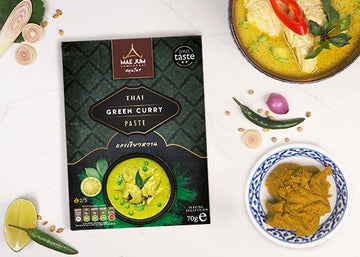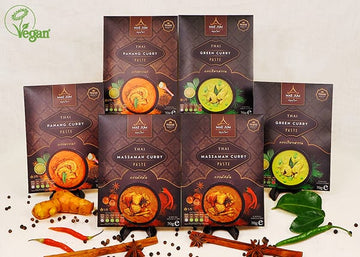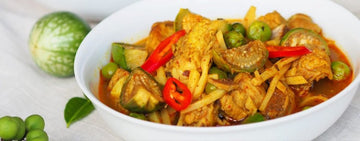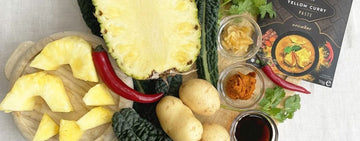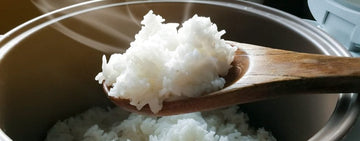Thai cuisine is a dazzling tapestry of flavours—sweet, salty, sour, bitter—but let's be honest, one thing it’s most famously known for is heat! If you’ve ever found yourself fanning your mouth after a fiery Thai curry, you've already met one of Thailand's favourite culinary weapons: the chilli. But did you know there are many different types of chillies used in Thai cooking, each with its own flavour, colour, and heat level?
Let’s dive in and get to know some of the essential Thai chillies that bring authentic Thai dishes to life.
Contents

The Mighty Bird's Eye Chilli (Prik Kee Noo)
Small but mighty, the Bird's Eye chilli, known in Thai as prik kee noo, is perhaps the most famous. These chillies are easy to spot, flaunting vibrant red or green skins and a fierce heat that hits fast and hard. If you've ever reached desperately for a glass of water after a spoonful of Thai curry or a zesty salad, you’ve likely encountered this fiery friend.
Did You Know? The name prik kee noo literally translates to "mouse dropping chilli" because of their tiny size—not the most glamorous nickname, but a hint at their potent power!
These chillies are significantly hotter than a jalapeño, and their fame stretches beyond Thailand. They’re also the secret behind the legendary Portuguese piri-piri sauce.
For the Brave: Prik Kariang
If Bird's Eye chillies aren't enough to satisfy your heat cravings, meet prik kariang. Sometimes simply called "bird chilli"—and if you're wondering about the difference between this chilli and the last, the answer is that this one is longer, while the Bird's Eye is shorter. This variety matures from green to brilliant shades of yellow, orange, and finally deep red.
What’s fascinating about prik kariang is the delayed heat. At first bite, you might think you've gotten away easy—but wait a few seconds, and a searing heat creeps in, often enough to bring a tear or two! We use these chillies in our red curry paste for its warm, long-lasting heat.
These chillies can be tricky to find outside of specialist Asian markets, but if you’re a connoisseur of authentic Thai curries, they're worth the hunt.

The Everyday Favourite: Prik Jinda
For those who enjoy spice without the culinary fireworks, prik jinda is a perfect choice. Often used in authentic Thai curry pastes—including Mae Jum’s traditional recipes—these long, slender chillies are considered medium-hot by Thai standards.
Bear in mind, though, that "medium" in Thailand still packs a punch! Prik Jinda has a fresh, grassy flavour that layers beautifully with herbs and spices.
Mild and Mellow: Prik Yuak
If you’re new to Thai cuisine or prefer to explore the flavours without a full-on chilli burn, prik yuak is your new best friend. Pale green and larger than other varieties, these chillies are much milder but still wonderfully flavourful.
They’re a popular addition to Thai salads and side dishes where you want a whisper of heat rather than a shout. At Mae Jum, we use a blend of this chilli and Prik Jinda for our green curry paste to balance the sweet and spicy flavours.

A Little Heat, A Lot of Health
Chillies don’t just fire up your taste buds—they’re packed with health benefits too! Rich in Vitamin C, chillies can give your immune system a lovely boost. They also deliver potassium and copper, which support heart health and strong bones, and Vitamin B6 to help speed up your metabolism.
Did You Know? Chillies are naturally low in carbs, making them a handy addition to a healthy diet. In fact, regular (but sensible!) consumption might even support weight management goals.
For a deeper dive into the health benefits of Thai chillies, check out our blog: Get to Know: Red and Green Chilli.
A Word to the Wise
Thai chillies are a joy to cook with, but they demand respect. A little goes a long way! Always start with less than you think you need—you can always add more, but you can't take it out.
And if you’re looking to create authentic Thai curries at home, you’ll be pleased to know that Mae Jum’s curry pastes are made using traditional recipes with just the right balance of chillies and spices. So take this advice when cooking with our curry pastes too—start with less and add more later!
Ready to Spice Up Your Kitchen?
Exploring the world of Thai chillies is a journey into the heart of Thai cooking. Whether you’re a heat-seeker or prefer a gentler introduction, there’s a chilli out there for you.
Why not experiment by making your own traditional Thai curry? You’ll find plenty of authentic recipes on our website—visit Mae Jum’s recipes and start your delicious adventure!
We’d love to hear about your chilli experiences too—share your favourite spicy dishes with us in the comments!
If you enjoyed reading about the magic of Thai chillies, please give this post a rating and subscribe for new blog updates and recipes. Follow and tag us @maejumsamunprai on social media for great foodie content and giveaway competitions! Read more on our blogs today!
